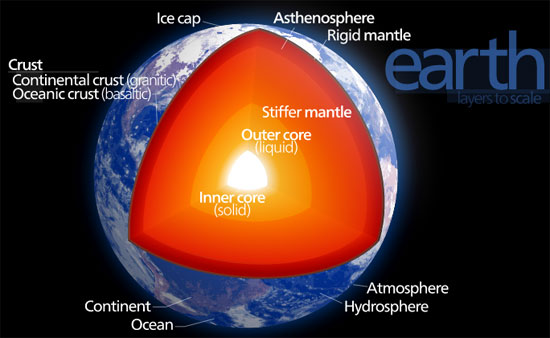Detecting Earth core layers rotate in different directions
According to a new study by British and Swiss scientists, the Earth's core is more complex than we think with layers rotating in different directions. This may explain a mystery about Earth's magnetic field that has existed for more than 300 years.
>>> Thecore of the Earth rotates at an unstable speed
The Earth core is separated into two different layers. In the center is a solid inner core surrounded by a loose outer core - both are made of a mixture of nickel and iron. Scientists have shown this two-layer structure decades ago and discovered that it is the turning in the hot, liquid metal of the outer shell that creates the Earth's magnetic field.

2 layers of Earth's core rotate in different directions
However, there are some things about the Earth core that are still mysterious. A 2005 study revealed that, although the inner core rotates in the same direction as the surface, it actually rotates a little faster than the surface. This bizarre result also coincides with another discovery in 1692, when astronaut Edmond Halley discovered that every decade passed, Earth's magnetic field "drifted" a few degrees westward.
A new study finally gave an explanation for the above two mysteries.
The researchers not only confirmed that the inner core rotates faster than the surface that I discovered the outer core rotates in the opposite direction. To find out what's going on, they used Monte Rose supercomputers to run a hypothetical program about 100 times more accurate than the previous model of the Earth core.
This model shows that the Earth's own magnetic field causes such core layers to rotate like that. It creates additional thrust for the inner core, adding force to the east, and a similar and opposite reaction that creates a reverse rotation to the outer shell, facing west.
The findings also explain the mystery of Halley astronaut. Since the outer core rotated slowly to the west, the rotation inside the liquid metal was also in that direction and the magnetic field also "floated" with them.
Researchers hope that all of this will help scientists understand more about Earth's core and magnetic activity.
- Discover one more layer of the earth's core
- The nucleus of the Earth - Earth core
- Earth turns slower because of global warming
- Decipher the mystery of the Earth's inner core
- Find out the last ingredient that makes up the Earth core
- Earth's core temperature is unexpectedly high
- The core of the Earth leaked more than 2.5 billion years ago, what is happening?
- For the first time, we have evidence that Earth's inner core exists in solid form
- May 13: Celebrating 128 years of birth, the person who finds Earth's core
- New hypothesis about the behavior of the Earth's core
- Discovering the 720,000-year-old ice core could be a
- New discovery of the heat of Earth's core coating
 'Fine laughs' - Scary and painful torture in ancient times
'Fine laughs' - Scary and painful torture in ancient times The sequence of numbers 142857 of the Egyptian pyramids is known as the strangest number in the world - Why?
The sequence of numbers 142857 of the Egyptian pyramids is known as the strangest number in the world - Why? History of the iron
History of the iron What is alum?
What is alum?